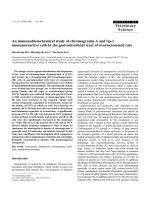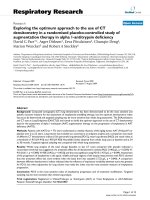Study of cost economics of management of chilli mites through abamectin 1.8 EC
Bạn đang xem bản rút gọn của tài liệu. Xem và tải ngay bản đầy đủ của tài liệu tại đây (451.71 KB, 5 trang )
Int.J.Curr.Microbiol.App.Sci (2018) 7(9): 1659-1663
International Journal of Current Microbiology and Applied Sciences
ISSN: 2319-7706 Volume 7 Number 09 (2018)
Journal homepage:
Original Research Article
/>
Study of Cost Economics of Management of Chilli Mites through
Abamectin 1.8 EC
Akhilesh Kumar1, Alpana Sharma2, Neelu Vishwakarma3 and Mrigendra Singh2
1
JNKVV-Krishi Vigyan Kendra, CoA, Rewa-486 001 (M.P.), India
2
JNKVV-Krishi Vigyan Kendra, Shahdol (MP), India
3
JNKVV-Krishi Vigyan Kendra, Jabalpur (MP), India
*Corresponding author
ABSTRACT
Keywords
Chilli, Abamectin 1.8EC,
Polyphagotarsonemus
latus, Yield and B: C
ratio
Article Info
Accepted:
10 August 2018
Available Online:
10 September 2018
The study was conducted on the assessment of management of chilli mites
Polyphagotarsonemus latus Banks using Abamectin 1.8 EC. The study was carried as OnFarm –Trials at farmer’s fields in Sinduri village of Shahdol district (M.P.) during Kharif
(2012-2013). Two sprays of Abamectin 1.8 EC @ 750 ml/ha at 15 days interval were
applied on farmers fields as research practice (RP) and compared with farmers practise
fields of indiscriminate use of insecticides. The Abamectin 1.8 EC treated fields showed
0.75 mites/leaf while, farmers practise fields showed 1.80 mites/leaf. The technology
assessed showed promising and positive results with yield of 120 (q/ha) and net return of
139650 (Rs./ha) as compared to farmers practices of yield 78 (q/ha) and net return of
76100 (Rs./ha) of chilli crop. Thus, the technology was found suitable for mites
management in Chilli showing reduction in mites infestation. The benefit cost ratios (B: C)
were found to be 2.83 and 2.19, respectively in Abamectin 1.8 EC treated fields and
farmers practice fields, respectively.
Introduction
Chilli (Capsicum annuum L.) is one of the
important vegetable crops grown throughout
the tropics and warm temperate regions of the
world.
Although there is a scope to enhance the
productivity of chilli, a number of limiting
factors have been attributed for the low
productivity, among which, the damage
caused by insect pests and mites is of
paramount importance. India accounts for
about 25% of the world total production of
chilli (Nayaka et al., 2009) and it is a major
exporter of chilli to Sri Lanka, USA, Nepal,
Mexico and Bangladesh (Jagtap et al., 2012).
The yellow mite, Polyphagotarsonemus latus
Banks and thrips, Scirtothrips dorsalis Hood
are two important sucking pests of chilli with
30-55% severity causing extensive leaf curl
and yield loss (Rai et al., 2007). The
tarsonemid mites are an important pest and
infested leaves become bronzed with downcurling margins, buds are aborted and flowers
distorted, shoots grow twisted and fruit may
be misshapen and russeted and yield loss goes
1659
Int.J.Curr.Microbiol.App.Sci (2018) 7(9): 1659-1663
up to 94 per cent under favourable conditions.
Imidacloprid, a systemic insecticide of
neonicotinoids group recommended in chilli is
known to cause resurgence in mite
(Srinivasulu et al., 2002).
Abamectin is a natural fermentation product of
the soil bacterium Streptomyces avermitilis
(Omura and Shiomi, 2007 and Pitterna et al.,
2009). Furthermore, Abamectin is a blend of
avermectins B1a and B1b, which contain at
least about 80% avermectin Bla and 20%
avermectin Blb (Pitterna, et al., 2009). These
two components, Bla and Blb, have very
similar biological and toxicological properties.
The Abamectin 1.8 EC is antibiotic insecticide
and acaricide with action of contact poisoning,
stomach poisoning and feeble fumigation. It
has distinct diffusion effect on the leaves.
After applied, the liquor rapidly impregnate
into epidermal tissue and forming the second
peak time of efficacy.
Materials and Methods
Management of mites in chilli crop (variety –
Kashi Anmol) through Abamectin 1.8 EC was
carried as Five Trials under OFT. The work
was carried in irrigated fields each of 2000 sq.
m area in village Sinduri of Shahdol District,
(M.P.) in Kharif (2012-2013). The technology
was to evaluate the performance of Abamectin
1.8 EC @ 750 ml/ha two sprays at 15 days
interval, and compared with farmers practices
of indiscriminate use of insecticides. The soil
was sandy loam in texture. Raising of chilli
crop was done as per standard agronomic
practices. Chilli crop was raised in nursery and
22 day old seedlings were transplanted at a
spacing of 50 cm x 50 cm. Further, the mite
population were studied by selecting and
tagging five plants randomly from each plot.
The mite population were counted from
different parts like upper, middle and lower
portion of the plant leaf and their mean
population were calculated per leaf.
Cost benefit ratio
The data were tabulated and calculated on the
basis of their yield performance. The fruit
yield from farmer’s field was recorded and
computed as quintal per hectare (q/ha). The
cost-benefit ratio (CBR) of different farmers
was calculated by estimating their cost of
cultivation and their returns from fruit yield
and computing them to per hectare piece of
land. The average market price of chilli
prevalent during the studied period was 18
(Rs/Kg). Cost benefit ratio was calculated
using the following formula:
Average gross return –
Average cost of cultivation
CBR = -----------------------------------Average cost of cultivation
Results and Discussion
Table 1 and Figure 1a, 1b and 1c showed the
efficacy of Abamectin 1.8 EC i.e.
effectiveness of acaricide against chilli mite,
Polyphagotarsonemus latus Banks over the
farmers practice. The adults and nymphs of
mites generally suck sap from leaves, petioles
and tender twigs. The margin of the young
leaves curled downwards in an inverted boat
shaped manner. The leaves look shiny, and
silvery lining was recorded on the ventral
surface. However, the older leaves and
petioles were found elongated. In severely
infested plant, leaves and terminal twigs
become hardened, twisted and thickened.
Infested plant produced very small sized
leaves. In such a plant most of the young fruits
look silvery and shiny, and in later stage the
fruits become cracked and deformed (Mondal
and Mondal, 2012). The post treatment effect,
after sprayed, indicated a significant reduction
in the population of mites in the acaricide
treated plot (Research practice) than untreated
control (farmer practice).
1660
Int.J.Curr.Microbiol.App.Sci (2018) 7(9): 1659-1663
Table.1 Economics viability of Abamectin 1.8 E.C. for mites management in chilli crop
Av. Cost of
cultivation
(Rs/ha)
FP
(T1)
63900
RP
(T2)
76350
No. of
(mites/leaf)
FP
(T1)
1.8
RP
(T2)
0.75
Reduction in
mites
infestation
(%)
FP
RP
(T1) (T2)
58.33
Yield (q/ha)
Yield
enhancemen
t (%)
Average Gross
Return (Rs/ha)
Av Net Return
(Rs/ha)
B:C
Ratio
FP
(T1)
78
FP
(T1)
-
FP
(T1)
140000
FP
(T1)
76100
FP
(T1)
2.19
RP
(T2)
120
Fig.1a
RP
(T2)
35
RP
(T2)
216000
Fig.1b
Fig.1c
1661
FP
(T2)
139650
RP
(T2)
2.83
Int.J.Curr.Microbiol.App.Sci (2018) 7(9): 1659-1663
The average number of mites varied from
0.75 to 1.80 (mites/leaf). The Abamectin 1.8
EC treated fields showed 0.75 (mites/leaf)
while, farmers practise fields showed 1.80
(mites/leaf) and promising yield of 120 (q/ha)
giving a net return of 139650 (Rs./ha) as
compared to farmers practices yield of 78
(q/ha) and net return of 76100 (Rs./ ha). The
assessed technology was found suitable for
mites management in chilli with reduction in
the infestation considerably. The benefit cost
ratios were 2.83 and 2.19, respectively in
Abamectin 1.8 EC treated fields and farmers
practices fields respectively. Thus, the
technology of two sprays of Abamectin 1.8
EC at 15 days interval was found to be
economically viable for management of crop
losses in chilly by mites in comparison with
farmers practices. Abamectin 1.8 EC @ 750
ml/ha was found superior over the farmer
practice with a percent reduction of 58.33 in
mites population and yield enhancement up to
35% over farmers practice. The Abamectin
1.8 EC was very effective in reducing the
mites infestation in chilli crop as well as also
increasing the fruit yield as also reported by
earlier scientist Mondal and Mondal (2012),
Nandini et al., (2012) and Sujay et. al. (2015).
Economics viability of Abamectin 1.8 E.C.
for mites management in chilli crop are
presented in Table 1. Based on average fruit
yield and prevalent market price of chilli Cost
Benefit Cost Ratio (B: C) was calculated. The
benefit cost ratio was found to be 2.83 in
Abamectin 1.8 EC treated fields and 2.19 in
farmers practice fields. Vishwakarma et al.,
(2010) also calculated B: C ratio for different
treatments against yellow mite in chilli crop.
References
Jagtap PP, Shingane US and Kuikarani KP.
2012. Economics of Chilli Production in
India. African Journal of Basic Applied
Sciences 4:161-164.
Mondal B. and Mondal P. 2012. Ecofriendly
pest management practices for leaf curl
complex of chilli (Capsicum annuum
L.). Journal of Biopesticides 5
(Supplementary): 115-118.
Nandini G, RS, Mantur SM and Patil RK.
2012. Evaluation of biopesticides
against Capsicum pests under protected
cultivation. Annals of Plant Protection
Sciences 20(1): 120-25.
Nayaka CS, Udaya AC, Niranjan SR, Prakash
HS and Mortensen CN. 2009.
Anthracnose disease of chilli pepper.
Asian Seed Health Centre Technical
Bulletin pp 1-13.
Omura S and Shiomi K. 2007. Discovery,
chemistry, and chemical biology of
microbial products. Pure and Applied
Chemistry 79: 581-591.
Pitterna T, Cassayre J, Hüter OF, Jung PM,
Maienfisch P, et al., 2009. New
ventures
in
the
chemistry of
avermectins. Bioorganic & Medicinal
Chemistry 17: 4085-4095.
Rai AB, Satpathy S, Gracy, RG,
Shivalingaswamy, TM and Rai M.
2007.
Yellow
mite
(Polyphagotarsonemus latus Banks)
menace in chilli crop. Vegetable
Science 34(1): 1-13.
Srinivasulu P, Naidu VG and Rao NV. 2002.
Evaluation of different pesticides for the
control
of
yellow
mite,
Polyphagotarsonemus latus (Banks) on
chilli. Journal of Applied Zoological
Research 13(1): 71-72.
Sujay YH, Giraddi RS and Udikeri SS. 2015.
Efficacy of New Molecules and
Botanicals against Chilli (Capsicum
annuum L.) Pests. The Madras
Agricultural Journal 102 (10-12): 348352.
Vishakarma R, Ghatak, SS and Mondal S.
2010. Bio-efficacy of some organic
formulations and novel pesticides
against
chilli
mite,
1662
Int.J.Curr.Microbiol.App.Sci (2018) 7(9): 1659-1663
Polyphagotarsonemus latus Banks
(Tarsonemidae).
In:
International
Symposium-cum
Workshop
Acarology, Kalyani, India, 78 P.
in
How to cite this article:
Akhilesh Kumar, Alpana Sharma, Neelu Vishwakarma and Mrigendra Singh. 2018. Study of
Cost Economics of Management of Chilli Mites through Abamectin 1.8 EC.
Int.J.Curr.Microbiol.App.Sci. 7(09): 1659-1663. doi: />
1663









